
My Years in the SLBM Program
Mr. Alan J. Dean
This article is a personal recollection of NSWC Dahlgren Division’s (NSWCDD) role in the Submarine Launched Ballistic Missile Program. All photographs are NSWCDD released unless otherwise noted.
Last December, the Submarine Launched Ballistic Missile (SLBM) Program celebrated its 60th year anniversary at Dahlgren. A program of this longevity has many stories to tell. The following are my recollections of a small part of that longevity story which intertwined my career and the program.
It was the dog days of summer, August 1977, when I came back to the SLBM Program. In 1974, my first year at Dahlgren, I had a developmental assignment in KGM, the Systems Engineering Branch with Mr. Bill Keiner, Mr. Harold Anderson, Ms. Donna Merritt (Elliot), and Wallace “Rusty” Hayes. My Junior Professional Developmental assignment was a good one, working on the Logic Simulation Program (LSP), a program that modeled digital electronic circuits. The LSP was intended to assist in generating digital logic test cases or Fault Dictionaries to discover hardware errors for use on the Trident I System. I enjoyed the group of people I worked with and my tasks. I finished my other three assignments and returned to my home branch (DK20) to work on the A6 Aircraft Fire Control Computer Programming effort.
In early 1977 Naval Sea System Command announced the A6 program was being transferred to China Lake as part of a reorganization. I had established roots in King George and did not want to move to California, so I was given permission to look for another assignment in Dahlgren. I thought back to my developmental assignments and called Bill to find out if there was a position available. There was, so after being on the base for three years, I restarted my career that August. Little did I know then I would spend the next 23+ years with the [Trident] Program. During this tenure, I shared with multiple colleagues the many experiences of developing the Trident I and II systems. The following is only a snippet of these experiences.
The Trident I system was a follow-on to the successful Polaris and Poseidon programs submarine-launched missile systems.
These systems had help propel the United States into the lead in strategic weapon deterrent systems, but the Cold War was reaching its peak and the United States needed to continue to excel in keeping this lead. Technology was changing rapidly and to keep this lead, the accuracy and range of the weapon system needed to be improved. This also meant a new missile would be deployed, Trident I (C4). In addition, the Poseidon Fire Control System was a transistor-based system written in assembly language. The hardware needed to be upgraded to an integrated circuit-based system to improve the system’s reliability, testability, and maintainability. The Fire Control software had to be modified to run on this new hardware and expanded to handle new accuracy and range computations, which impacted all phases of software development from design to delivery.
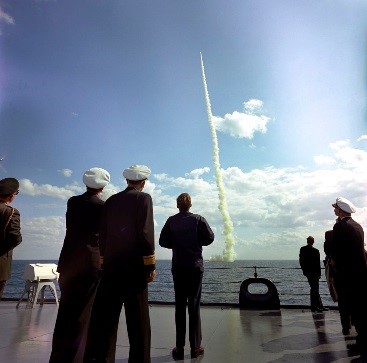
During a 16 November 1963 visit aboard USS Observation Island (EAG-154), President John F. Kennedy, center, watches a USS Andrew Jackson (SSBN-619) demonstration of the firing of a Polaris A-2 missile off the coast of Florida. (Robert Knudsen, White House Photographs, John F. Kennedy Presidential Library and Museum, Boston)
While analysts worked the new accuracy, range, and computational aspects of the effort, the Fire Control software developers busied themselves developing third-generation Trident High-level Language to write fire control programs led by Dr. Hartmut Huber, software development debug programs for laboratory use, new quality assurance methods to assist in ensuring the software had near-zero software defects, developing new tactical software programs to run on the designed-from-scratch Trident I computer, and expanding computer facilities to house the software development and test laboratory.
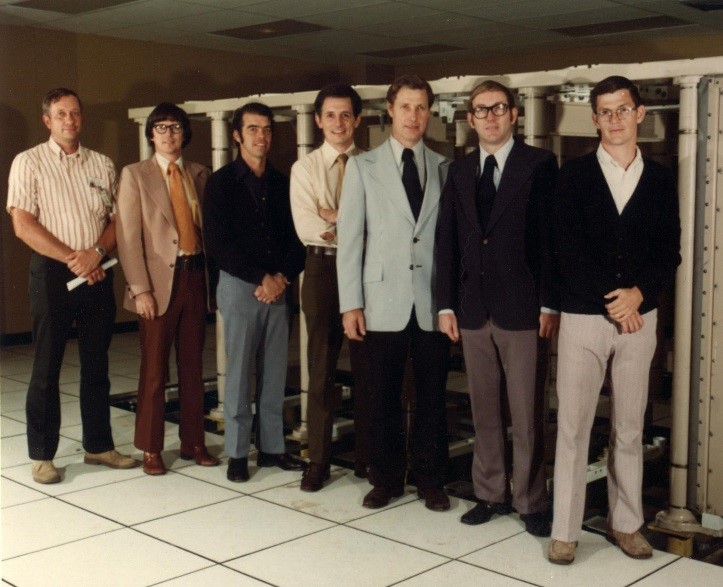
Standing in front of the Trident I door-and-post structure, left to right, unknown, Roger Carson, Don Edwards, Carlton Duke, Jack Carlock, Ray Hughey, and Dan Duncan.
Those of us in KGM continued developing the LSP, integrating the new digital electronic elements for Trident I. All efforts were done in concurrence with supporting the deployed Polaris and Poseidon systems. The Trident C4 missile deployed on back-fit Poseidon submarines in 1979. The first Trident I submarine, USS Ohio (SSGN 726), deployed on its first strategic deterrent patrol in October 1982.
Even before Trident I deployed, work began on the next-generation Undersea Launch Missile System to again expand accuracy and range requirements of the system and add a new, larger missile, Trident II (D5). (The Trident submarines were designed to accommodate both size missiles). The effort to maintain remaining Polaris and Poseidon systems, the new Trident I and ramping up to support Trident II, and the rapid growth of computer technology expanded the effort at Dahlgren so much that in the early 1980s, the SLBM effort was split between two divisions. K40 (now A10) focused on the analysis, analytics, and computations to address missile analysis, accuracy, and range improvements; and K50 (now A20) addressed software development, quality assurance, delivery to the Fleet, and facilities.
The work in my branch had dwindled significantly, and the Branch Head, Mr. Ray Pollock, was asked to lead a new Dahlgren effort: Tomahawk. The rest of the personnel either left for other efforts such as Tomahawk or Aegis or, with their work, were dispersed among other newly formed K50 branches. As for me, I moved to K53, the Systems Employment and Product Engineering Branch, under Ms. Sheila Young. Within a short time, after another small K50 reorganization, I landed in K54 under Mr. Dan Duncan. I had become heavily involved in developing the Verification and Evaluation System for Trident (VEST), led by Mr. Willie “Mac” McCoy. The Trident I computer was designed with a real-time (every 125 milliseconds) computer performance evaluation data output. The thought was at some time in the future, when technology was available, to build a data collection device to capture in the lab this computer performance data to enhance programmers and quality assurance personnel efforts in debugging and validating the software's interaction with the hardware. VEST was this device.
VEST also required a substantial rata reduction software development. This software was developed by a team in K50 led by Mr. Sid Hankerson.
By that time, I was also in charge of a small group responsible for writing the Trident II standalone programs used to initialize and load the first Trident II tactical, data entry, and standby programs from the high-density magnetic tape (HDMT) to the new mass memory subsystem (MMSS). These programs were needed because from Trident I to Trident II tactical software delivery moved from the “easily” removable magnetic disks (picture below) to the HDMT. This switch was made because the new MMSS XX MB magnetic disk was considered non-removable. To make these standalone programs work, it was necessary to write and test programs to exercise the subsystem interface protocols that were also used at General Electric in Pittsfield, Massachusetts, to assist in hardware debugging of the actual HDMT and MMSS interface hardware. This interface testing required weekly trips to Pittsfield over several months.

Cartoon of Typical Hardware Checkout Environment
Also during this time, the production version of the VEST prototype hardware Dahlgren had built was also being built at General Electric in Pittsfield. To minimize impacts of using a real Trident Basic Processor (BP), which houses the Performance Evaluation Interface (PEI), Dahlgren was tasked with building a PEI simulator, which was programmable to act like the BP, to validate the new VEST hardware worked. After VEST hardware acceptance and delivery, the simulator continued to verify the hardware worked during its production use.
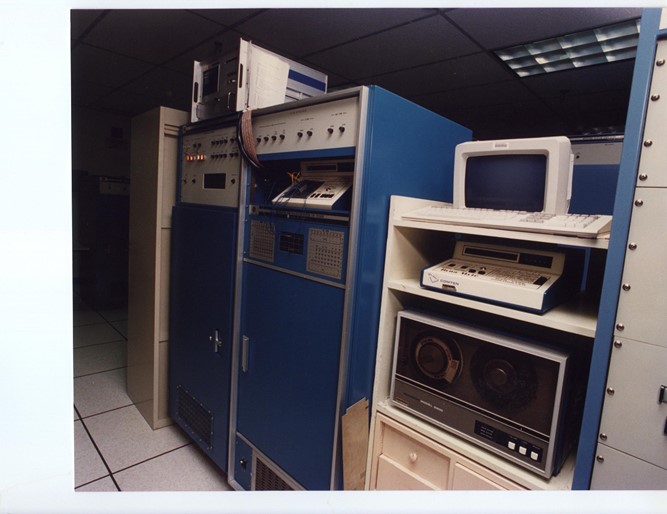
VEST Production Version
By 1989, after a series of test pad successes, the D5 missile was ready for a submarine launch test. The first test did not go well. The missile came out of the water and after the rockets ignited, did a 360° spiral and had to be destroyed.
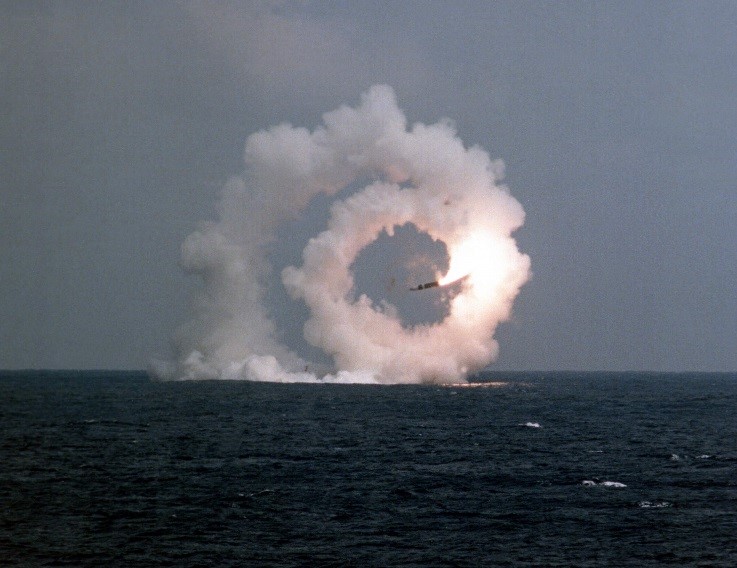
A D-5 Trident II missile spins out of control after being launched from USS Tennessee (SSBN-734), March 1989. (U.S. Navy released, U.S. National Archives)
Dr. Rob Gates, K44 Branch Head, the missile assessment group, speculated the rocket nozzles had somehow been jammed hard over, and modified the K44 missile software model to account for this failure. Sure enough, the missile model mimicked the actual test. After the Trident contractor-government team determined the cause of failure: the plume of water following the missile rose to greater height than expected, resulting in water in the nozzle when the motor ignited. The fix is a systems engineering story on its own, all subsequent test launches to today have been successful. USS Tennessee deployed for the first strategic deterrent patrol with D5 missiles in March 1990.
With deployment, the program’s focus again shifted to accuracy, system efficiency and effectiveness, and technology upgrades in the early 1990s. Commercial industry had accelerated the production quality of computers and computer subsystems so that it was becoming too expensive to “stick build” the computer-based Fire Control System as was done in all previous SLBM versions. The introduction of commercial off-the-shelf hardware launched the next Trident II system technology upgrades. First up was the Mass Memory Subsystem led by Ms. Donna Hill, Dahlgren Project-Leader Coordinator. By this time, I was K55 (now A24) Branch Head after serving as the SLBM Retargeting System project manager. K55, the Facilities and Engineering group that oversaw the MMSS effort was also responsible for all SLBM facilities at Dahlgren. This upgrade included the Fire Control testbeds, data links, auxiliary equipment, and the software developmental platforms used by K40 and K50, which were estimated to be worth $150M. During the mid-1980s, Trident Tactical and Support software development moved from the big Dahlgren mainframe computers to a mid-sized computer interactive system built by Digital Equipment Corporation, the VAX 11-780.
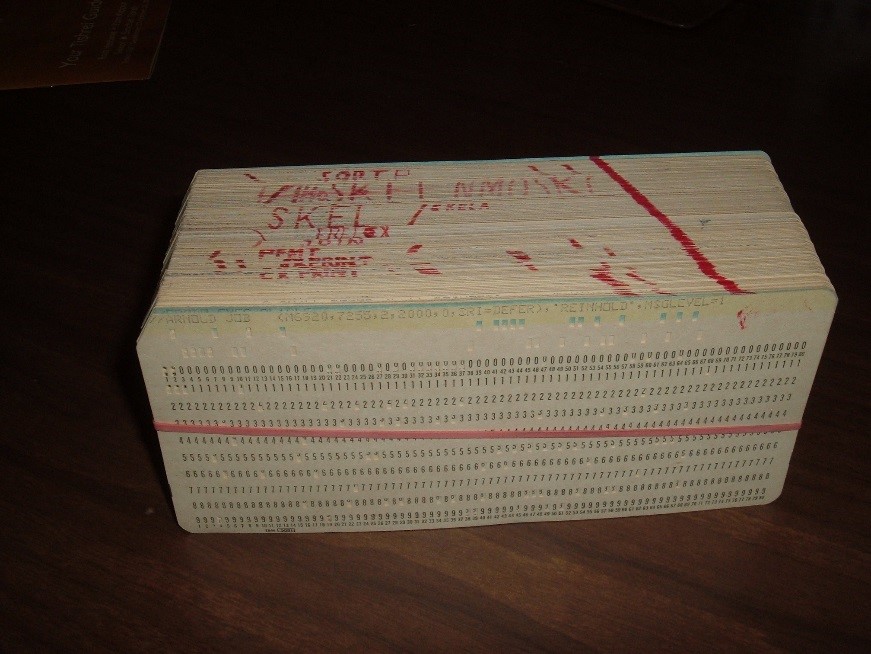
Computer punch card deck (circa 1969) donated to the MIT Computer Museum in 2006 by Arnold Reinhold. (Photo by Arnold Reinhold, licensed under the Creative Commons Attribution-Share Alike 3.0 Unported license.)
This move was designed to increase programmer productivity by placing interactive terminals on each programmer’s desktop, which required installing networks from the VAX to each desktop with the added complication that some programs required classified levels to operate. Through the leadership of Mr. Manfred Slack, Mr. John Lunney, Mr. Robert Bevan, and Mr. Sid Hankerson, this “distributed” system was in place in time for developing the first Trident II software. Gone were the days of preparing card decks for central computer operators to load, run, and provide the printed or magnetic tape outputs, which sometimes took 2–4 hours or overnight. Now programmers could sit at their desks and write the program, run the program, and see the results with little delay.
As with the technology acceleration impacting the Trident Fire Control hardware, technology obsolescence issues arose in the support environments. By the early 1990s, VAX systems were fast becoming obsolete. The new technology was a distributed server design led by such corporations such Sun Microsystems, Inc. (now owned by Oracle Corporation). This obsolescence required a complete redesign of the SLBM interactive software development environment at Dahlgren. A K55 team led by Mr. Shane Rice and Ms. Roberta Canaan implemented the first upgrade to the software development environment to a Sun server environment.
By 1999, I had moved to K50 staff assisting in Dahlgren SLBM strategic planning and leading the K Department Y2K (aka year 2000) team effort. In 2000, I got a call from Mr. Ralph Fallin, a former SLBM branch head, who was the Chief Learning Officer on Dahlgren’s Headquarters staff. After 23 years with the program that had provided many opportunities to grow my career, I decided to join the staff, again restarting my career in a completely new field using the knowledge I had gained to assist others in their development.
Over the 23 years, I had the opportunity to be a hardware designer, software designer, computer performance analyst, group leader, project manager, branch head, and an organizational strategic planner. I witnessed the dizzying paced mission, process, and technology change. Most of all though, I remember how the Dahlgren SLBM family created new processes, technologies, products, and strategies, or adapted existing ones to meet the ever-changing mission requirements to fulfill the nation’s strategic needs. I witnessed the selfless dedication, professionalism, passion, and excitement as individuals worked each day on the program. In this account I have mentioned only a few from this community. Each has their unique story to tell. It is to all of them and their silent service I dedicate this article.
The SLBM story does not end there. With the completion of the new facility at Building 1561, the SLBM Program, under the leadership of Ms. Kim Payne (A10) and Ms. Lori Buckwalter (A20), continues as strong today and into the future as it has always been, delivering upgrades to the fleet that continue to enhance the effectiveness of the platform and keeping America’s strategic deterrent the best in the world.
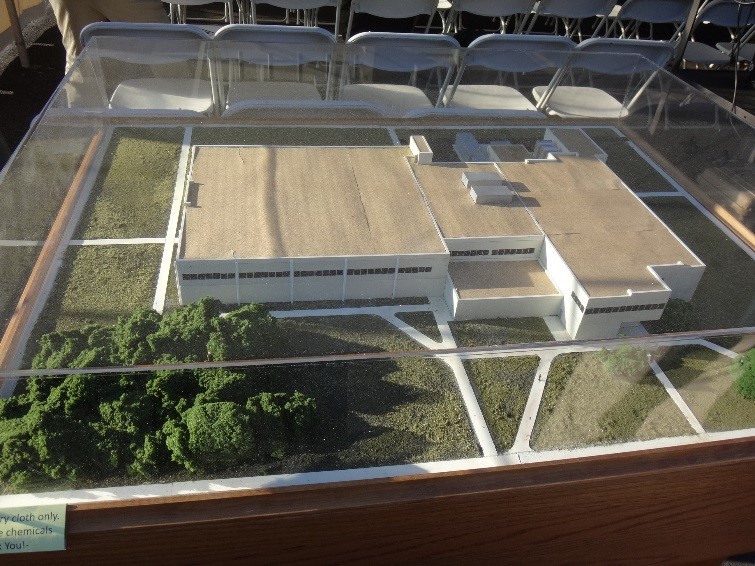
Artist’s Model of Building 1561.